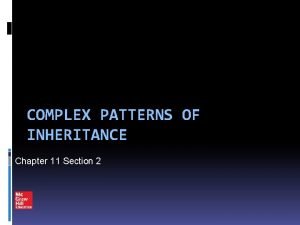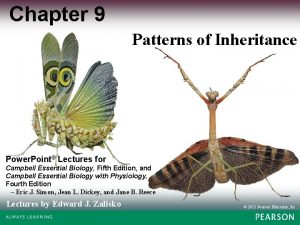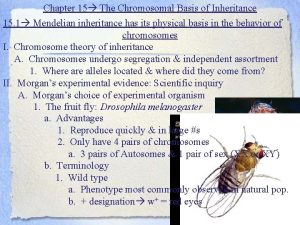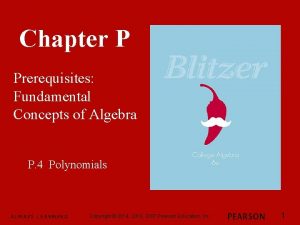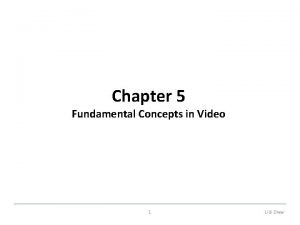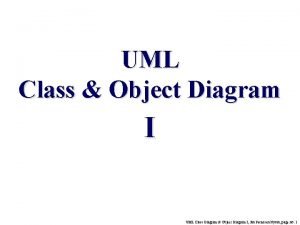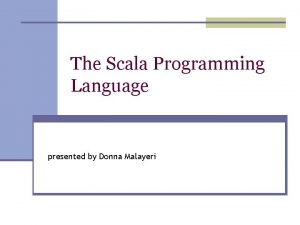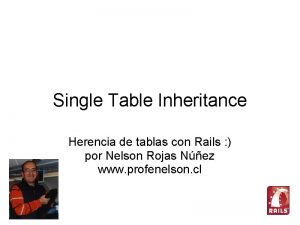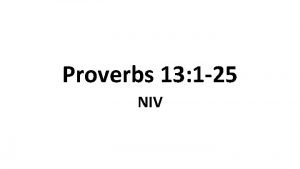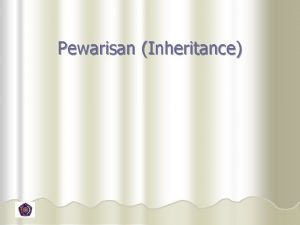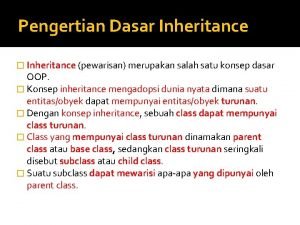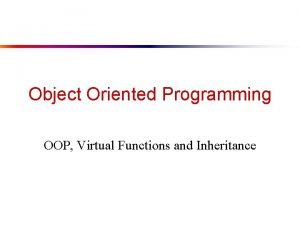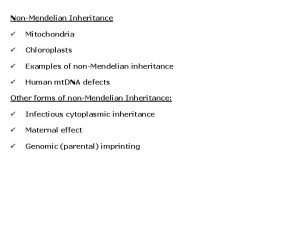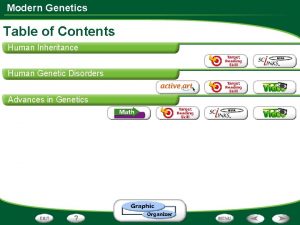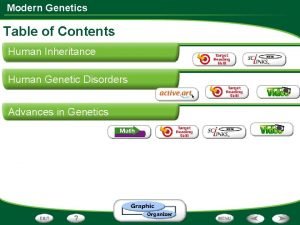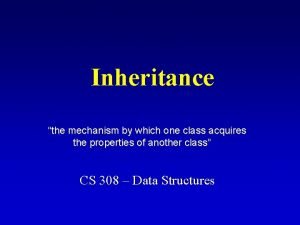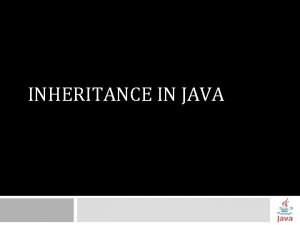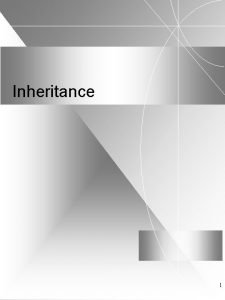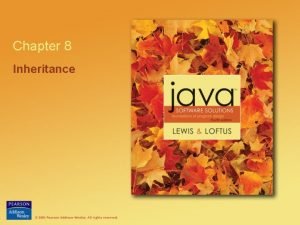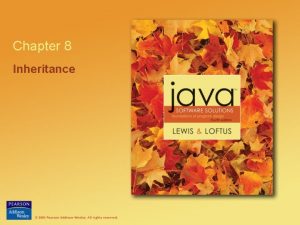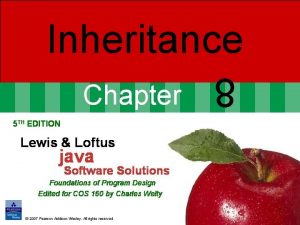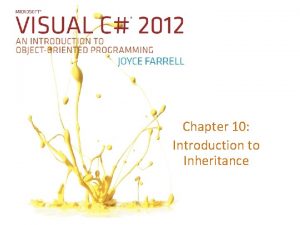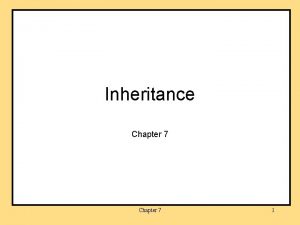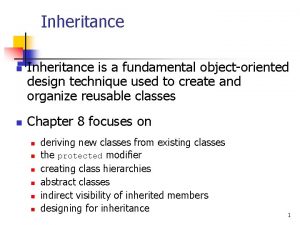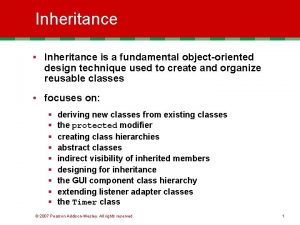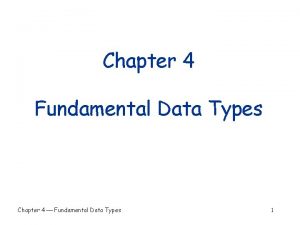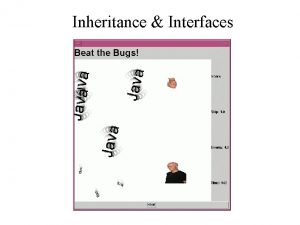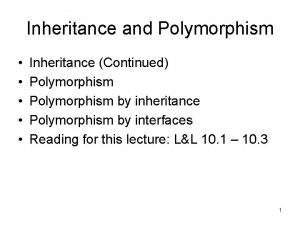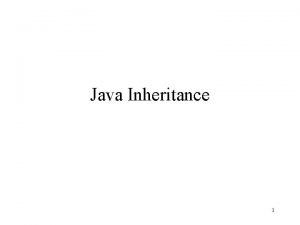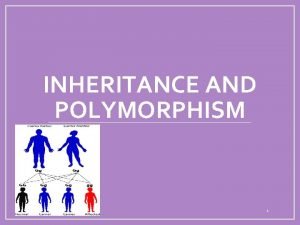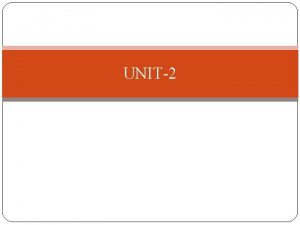Chapter 8 Inheritance Inheritance Inheritance is a fundamental


















































- Slides: 50

Chapter 8 Inheritance

Inheritance • Inheritance is a fundamental object-oriented design technique used to create and organize reusable classes • Chapter 8 focuses on: § § § deriving new classes from existing classes the protected modifier creating class hierarchies abstract classes indirect visibility of inherited members designing for inheritance © 2004 Pearson Addison-Wesley. All rights reserved 2

Outline Creating Subclasses Overriding Methods Class Hierarchies Inheritance and Visibility Designing for Inheritance © 2004 Pearson Addison-Wesley. All rights reserved 3

Inheritance • Inheritance allows a software developer to derive a new class from an existing one • The existing class is called the parent class, or superclass, or base class • The derived class is called the child class or subclass • As the name implies, the child inherits characteristics of the parent • That is, the child class inherits the methods and data defined by the parent class 4

Inheritance • Inheritance relationships are shown in a UML class diagram using a solid arrow with an unfilled triangular arrowhead pointing to the parent class Vehicle Car • Proper inheritance creates an is-a relationship, meaning the child is a more specific version of the parent 5

Inheritance • A programmer can tailor a derived class as needed by adding new variables or methods, or by modifying the inherited ones • Software reuse is a fundamental benefit of inheritance • By using existing software components to create new ones, we capitalize on all the effort that went into the design, implementation, and testing of the existing software © 2004 Pearson Addison-Wesley. All rights reserved 6

Deriving Subclasses • In Java, we use the reserved word extends to establish an inheritance relationship class Car extends Vehicle { // class contents } • See Words. java (page 440) • See Book. java (page 441) • See Dictionary. java (page 442) 7

Book. java public class Book { protected int pages = 1500; //-----------------------------// Pages mutator. //-----------------------------public void set. Pages (int num. Pages) { pages = num. Pages; } //-----------------------------// Pages accessor. //-----------------------------public int get. Pages () { return pages; } } © 2004 Pearson Addison-Wesley. All rights reserved 8

Dictionary. java public class Dictionary extends Book { private int definitions = 52500; // Prints a message using both local and inherited values. public double compute. Ratio () { return definitions/pages; } // Definitions mutator. public void set. Definitions (int num. Definitions) { definitions = num. Definitions; } // Definitions accessor. public int get. Definitions () { return definitions; } } © 2004 Pearson Addison-Wesley. All rights reserved 9

Words. java public class Words { //-----------------------------// Instantiates a derived class and invokes its inherited // and local methods. //-----------------------------public static void main (String[] args) { Dictionary webster = new Dictionary(); System. out. println ("Number of pages: " + webster. get. Pages()); System. out. println ("Number of definitions: " + webster. get. Definitions()); System. out. println ("Definitions per page: " + webster. compute. Ratio()); } } © 2004 Pearson Addison-Wesley. All rights reserved 10

The protected Modifier • Visibility modifiers affect the way that class members can be used in a child class • Variables and methods declared with private visibility cannot be referenced by name in a child class • They can be referenced in the child class if they are declared with public visibility -- but public variables violate the principle of encapsulation • There is a third visibility modifier that helps in inheritance situations: protected 11

The protected Modifier • The protected modifier allows a child class to reference a variable or method directly in the child class • It provides more encapsulation than public visibility, but is not as tightly encapsulated as private visibility • A protected variable is visible to any class in the same package as the parent class • The details of all Java modifiers are discussed in Appendix E • Protected variables and methods can be shown with a # symbol preceding them in UML diagrams 12

Class Diagram for Words Book # pages : int + page. Message() : void Words Dictionary - definitions : int + main (args : String[]) : void © 2004 Pearson Addison-Wesley. All rights reserved + definition. Message() : void 13

The super Reference • Constructors are not inherited, even though they have public visibility • Yet we often want to use the parent's constructor to set up the "parent's part" of the object • The super reference can be used to refer to the parent class, and often is used to invoke the parent's constructor • See Words 2. java (page 445) • See Book 2. java (page 446) • See Dictionary 2. java (page 447) 14

Book 2. java public class Book 2 { protected int pages; //-----------------------------// Constructor: Sets up the book with the specified number // of pages. //-----------------------------public Book 2 (int num. Pages) { pages = num. Pages; }. . . © 2004 Pearson Addison-Wesley. All rights reserved 15

Dictionary 2. java public class Dictionary 2 extends Book 2 { private int definitions; //-----------------------------// Constructor: Sets up the dictionary with the specified // number of pages and definitions. //-----------------------------public Dictionary 2 (int num. Pages, int num. Definitions) { super(num. Pages); definitions = num. Definitions; }. . . © 2004 Pearson Addison-Wesley. All rights reserved 16

The super Reference • A child’s constructor is responsible for calling the parent’s constructor • The first line of a child’s constructor should use the super reference to call the parent’s constructor • The super reference can also be used to reference other variables and methods defined in the parent’s class © 2004 Pearson Addison-Wesley. All rights reserved 17

Experiment public class Parent. Class { public Parent. Class() { System. out. println("In Parent. Class constructor"); } } public class Sub. Class 1 extends Parent. Class { public Sub. Class 1() { System. out. println("In Sub. Class 1 constructor"); } } public class Sub. Class 2 extends Parent. Class { public Sub. Class 2() { super(); System. out. println("In Sub. Class 2 constructor"); } Output: Creating an instance of Sub. Class 1 } In Parent. Class constructor In Sub. Class 1 constructor © 2004 Pearson Addison-Wesley. All rights reserved Creating an instance of Sub. Class 2 In Parent. Class constructor In Sub. Class 2 constructor 18

Multiple Inheritance • Java supports single inheritance, meaning that a derived class can have only one parent class • Multiple inheritance allows a class to be derived from two or more classes, inheriting the members of all parents • Collisions, such as the same variable name in two parents, have to be resolved • Java does not support multiple inheritance • In most cases, the use of interfaces gives us aspects of multiple inheritance without the overhead © 2004 Pearson Addison-Wesley. All rights reserved 19

Outline Creating Subclasses Overriding Methods Class Hierarchies Inheritance and Visibility Designing for Inheritance © 2004 Pearson Addison-Wesley. All rights reserved 20

Overriding Methods • A child class can override the definition of an inherited method in favor of its own • The new method must have the same signature as the parent's method, but can have a different body • The type of the object executing the method determines which version of the method is invoked • See Messages. java (page 450) • See Thought. java (page 451) • See Advice. java (page 452) 21

Thought. java public class Thought { //-----------------------------// Prints a message. //-----------------------------public void message() { System. out. println ("I feel like I'm diagonally parked" + " in a parallel universe. "); System. out. println(); } } © 2004 Pearson Addison-Wesley. All rights reserved 22

Advice. java public class Advice extends Thought { //-----------------------------// Prints a message. This method overrides the parent's // version. //-----------------------------public void message() { System. out. println ("Warning: Dates in calendar are " + "closer than they appear. "); System. out. println(); super. message(); // explicitly invokes the parent's // version } } © 2004 Pearson Addison-Wesley. All rights reserved 23

Messages. java public class Messages { //-----------------------------// Creates two objects and invokes the message method in // each. //-----------------------------public static void main (String[] args) { Thought parked = new Thought(); Advice dates = new Advice(); parked. message(); dates. message(); // overridden } } © 2004 Pearson Addison-Wesley. All rights reserved 24

Overriding • A method in the parent class can be invoked explicitly using the super reference • If a method is declared with the final modifier, it cannot be overridden • The concept of overriding can be applied to data and is called shadowing variables • Shadowing variables should be avoided because it tends to cause unnecessarily confusing code © 2004 Pearson Addison-Wesley. All rights reserved 25

Overloading vs. Overriding • Overloading deals with multiple methods with the same name in the same class, but with different signatures • Overriding deals with two methods, one in a parent class and one in a child class, that have the same signature • Overloading lets you define a similar operation in different ways for different parameters • Overriding lets you define a similar operation in different ways for different object types 26

Outline Creating Subclasses Overriding Methods Class Hierarchies Inheritance and Visibility Designing for Inheritance © 2004 Pearson Addison-Wesley. All rights reserved 27

Class Hierarchies • A child class of one parent can be the parent of another child, forming a class hierarchy Business Retail. Business KMart Service. Business Macys Kinkos 28

Class Hierarchies • Two children of the same parent are called siblings • Common features should be put as high in the hierarchy as is reasonable • An inherited member is passed continually down the line • Therefore, a child class inherits from all its ancestor classes • There is no single class hierarchy that is appropriate for all situations 29

The Object Class • A class called Object is defined in the java. lang package of the Java standard class library • All classes are derived from the Object class • If a class is not explicitly defined to be the child of an existing class, it is assumed to be the child of the Object class • Therefore, the Object class is the ultimate root of all class hierarchies 30

The Object Class • The Object class contains a few useful methods, which are inherited by all classes • For example, the to. String method is defined in the Object class • Every time we define the to. String method, we are actually overriding an inherited definition • The to. String method in the Object class is defined to return a string that contains the name of the object’s class along with some other information © 2004 Pearson Addison-Wesley. All rights reserved 31

The Object Class • The equals method of the Object class returns true if two references are aliases • We can override equals in any class to define equality in some more appropriate way • As we've seen, the String class defines the equals method to return true if two String objects contain the same characters • The designers of the String class have overridden the equals method inherited from Object in favor of a more useful version © 2004 Pearson Addison-Wesley. All rights reserved 32

Abstract Classes • An abstract class is a placeholder in a class hierarchy that represents a generic concept • An abstract class cannot be instantiated • We use the modifier abstract on the class header to declare a class as abstract: public abstract class Product { // contents } © 2004 Pearson Addison-Wesley. All rights reserved 33

Abstract Classes • An abstract class often contains abstract methods with no definitions (like an interface) • Unlike an interface, the abstract modifier must be applied to each abstract method • Also, an abstract class typically contains nonabstract methods with full definitions • A class declared as abstract does not have to contain abstract methods -- simply declaring it as abstract makes it so © 2004 Pearson Addison-Wesley. All rights reserved 34

Abstract Classes • The child of an abstract class must override the abstract methods of the parent, or it too will be considered abstract • An abstract method cannot be defined as final or static • The use of abstract classes is an important element of software design – it allows us to establish common elements in a hierarchy that are too generic to instantiate © 2004 Pearson Addison-Wesley. All rights reserved 35

Interface Hierarchies • Inheritance can be applied to interfaces as well as classes • That is, one interface can be derived from another interface • The child interface inherits all abstract methods of the parent • A class implementing the child interface must define all methods from both the ancestor and child interfaces • Note that class hierarchies and interface hierarchies are distinct (they do not overlap) © 2004 Pearson Addison-Wesley. All rights reserved 36

Outline Creating Subclasses Overriding Methods Class Hierarchies Inheritance and Visibility Designing for Inheritance © 2004 Pearson Addison-Wesley. All rights reserved 37

Visibility Revisited • It's important to understand one subtle issue related to inheritance and visibility • All variables and methods of a parent class, even private members, are inherited by its children • As we've mentioned, private members cannot be referenced by name in the child class • However, private members inherited by child classes exist and can be referenced indirectly 38

Visibility Revisited • Because the parent can refer to the private member, the child can reference it indirectly using its parent's methods • The super reference can be used to refer to the parent class, even if no object of the parent exists • See Food. Analyzer. java (page 459) • See Food. Item. java (page 460) • See Pizza. java (page 461) © 2004 Pearson Addison-Wesley. All rights reserved 39

Food. Item. java public class Food. Item { final private int CALORIES_PER_GRAM = 9; private int fat. Grams; protected int servings; //-----------------------------// Sets up this food item with the specified number of fat // grams and number of servings. //-----------------------------public Food. Item (int num. Fat. Grams, int num. Servings) { fat. Grams = num. Fat. Grams; servings = num. Servings; } © 2004 Pearson Addison-Wesley. All rights reserved 40

Food. Item. java //-----------------------------// Computes and returns the number of calories in this food // item due to fat. //-----------------------------private int calories() { return fat. Grams * CALORIES_PER_GRAM; } //-----------------------------// Computes and returns the number of fat calories per // serving. //-----------------------------public int calories. Per. Serving() { return (calories() / servings); } } © 2004 Pearson Addison-Wesley. All rights reserved 41

Pizza. java public class Pizza extends Food. Item { //-----------------------------// Sets up a pizza with the specified amount of fat // (assumes eight servings). //-----------------------------public Pizza (int fat. Grams) { super (fat. Grams, 8); } } © 2004 Pearson Addison-Wesley. All rights reserved 42

Food. Analyzer. java public class Food. Analyzer { //-----------------------------// Instantiates a Pizza object and prints its calories per // serving. //-----------------------------public static void main (String[] args) { Pizza special = new Pizza (275); System. out. println ("Calories per serving: " + special. calories. Per. Serving()); } } © 2004 Pearson Addison-Wesley. All rights reserved 43

Outline Creating Subclasses Overriding Methods Class Hierarchies Inheritance and Visibility Designing for Inheritance © 2004 Pearson Addison-Wesley. All rights reserved 44

Designing for Inheritance • As we've discussed, taking the time to create a good software design reaps long-term benefits • Inheritance issues are an important part of an object-oriented design • Properly designed inheritance relationships can contribute greatly to the elegance, maintainability, and reuse of the software • Let's summarize some of the issues regarding inheritance that relate to a good software design © 2004 Pearson Addison-Wesley. All rights reserved 45

Inheritance Design Issues • Every derivation should be an is-a relationship • Think about the potential future of a class hierarchy, and design classes to be reusable and flexible • Find common characteristics of classes and push them as high in the class hierarchy as appropriate • Override methods as appropriate to tailor or change the functionality of a child • Add new variables to children, but don't redefine (shadow) inherited variables © 2004 Pearson Addison-Wesley. All rights reserved 46

Inheritance Design Issues • Allow each class to manage its own data; use the super reference to invoke the parent's constructor to set up its data • Even if there are no current uses for them, override general methods such as to. String and equals with appropriate definitions • Use abstract classes to represent general concepts that lower classes have in common • Use visibility modifiers carefully to provide needed access without violating encapsulation © 2004 Pearson Addison-Wesley. All rights reserved 47

Restricting Inheritance • The final modifier can be used to curtail inheritance • If the final modifier is applied to a method, then that method cannot be overridden in any descendent classes • If the final modifier is applied to an entire class, then that class cannot be used to derive any children at all § Thus, an abstract class cannot be declared as final • These are key design decisions, establishing that a method or class should be used as is © 2004 Pearson Addison-Wesley. All rights reserved 48

Exercise • Design and implement a class called Monetary. Coin that is derived from the Coin class presented in Chapter 5. Store a value in the monetary coin that represents its value and add a method that returns its value. Create a main driver class to instantiate and compute the sum of several Monetary. Coin objects. Demonstrate that a monetary coin inherits parent's ability to be flipped. § Download Coin. java from the examples webpage for lecture 11: http: //www. cs. loyola. edu/~lawrie/CS 630/F 05/examples/Ex 11/ © 2004 Pearson Addison-Wesley. All rights reserved 49

Summary • Chapter 8 focused on: § § § § § deriving new classes from existing classes the protected modifier creating class hierarchies abstract classes indirect visibility of inherited members designing for inheritance the GUI component class hierarchy extending listener adapter classes the Timer class © 2004 Pearson Addison-Wesley. All rights reserved 50
 Chapter 11 section 2 complex patterns of inheritance
Chapter 11 section 2 complex patterns of inheritance Chapter 16 the molecular basis of inheritance
Chapter 16 the molecular basis of inheritance Chromosomal theory of inheritance
Chromosomal theory of inheritance Chapter 11 complex inheritance and human heredity test
Chapter 11 complex inheritance and human heredity test Chapter 9 patterns of inheritance
Chapter 9 patterns of inheritance The molecular basis of inheritance chapter 16
The molecular basis of inheritance chapter 16 Chapter 15 the chromosomal basis of inheritance
Chapter 15 the chromosomal basis of inheritance The chromosomal basis of inheritance chapter 15
The chromosomal basis of inheritance chapter 15 Chapter 15 the chromosomal basis of inheritance
Chapter 15 the chromosomal basis of inheritance Chapter 11 section 1 basic patterns of human inheritance
Chapter 11 section 1 basic patterns of human inheritance Chapter 11 section 1 basic patterns of human inheritance
Chapter 11 section 1 basic patterns of human inheritance Chapter 13-the molecular basis of inheritance
Chapter 13-the molecular basis of inheritance Chapter 9 patterns of inheritance
Chapter 9 patterns of inheritance Chapter 15 the chromosomal basis of inheritance
Chapter 15 the chromosomal basis of inheritance Fundamentals chapter 1
Fundamentals chapter 1 Chapter p prerequisites fundamental concepts of algebra
Chapter p prerequisites fundamental concepts of algebra Chapter p prerequisites fundamental concepts of algebra
Chapter p prerequisites fundamental concepts of algebra Chapter p prerequisites fundamental concepts of algebra
Chapter p prerequisites fundamental concepts of algebra Secam stands for
Secam stands for Prisma model inheritance
Prisma model inheritance Object diagram tutorial
Object diagram tutorial Priority inheritance
Priority inheritance Inheritance scala
Inheritance scala The inheritance of loss themes
The inheritance of loss themes Lionitis
Lionitis Single table inheritance rails
Single table inheritance rails Hemophilia cross punnett square
Hemophilia cross punnett square Sexlinked inheritance
Sexlinked inheritance Quantitative and qualitative traits
Quantitative and qualitative traits Proverbs 13:1-25
Proverbs 13:1-25 Tujuan inheritance
Tujuan inheritance Pengertian dari inheritance
Pengertian dari inheritance X-linked recessive pedigree chart
X-linked recessive pedigree chart Complete dominance pattern of inheritance
Complete dominance pattern of inheritance Private inheritance
Private inheritance Transovarial transmission คือ
Transovarial transmission คือ Non mendelian inheritance
Non mendelian inheritance Human inheritance modern genetics answer key
Human inheritance modern genetics answer key Human clone
Human clone Modern genetics human inheritance answer key
Modern genetics human inheritance answer key Epistatic inheritance
Epistatic inheritance Mendel's 3rd law of inheritance
Mendel's 3rd law of inheritance Hemophilia mode of inheritance
Hemophilia mode of inheritance Perservefamily/status
Perservefamily/status Dominant genetic variance
Dominant genetic variance Private inheritance
Private inheritance Spanish inheritance tax valencia region
Spanish inheritance tax valencia region Hierarchical inheritance in c++
Hierarchical inheritance in c++ Overloading and overriding
Overloading and overriding Advantages of inheritance
Advantages of inheritance Private inheritance
Private inheritance
